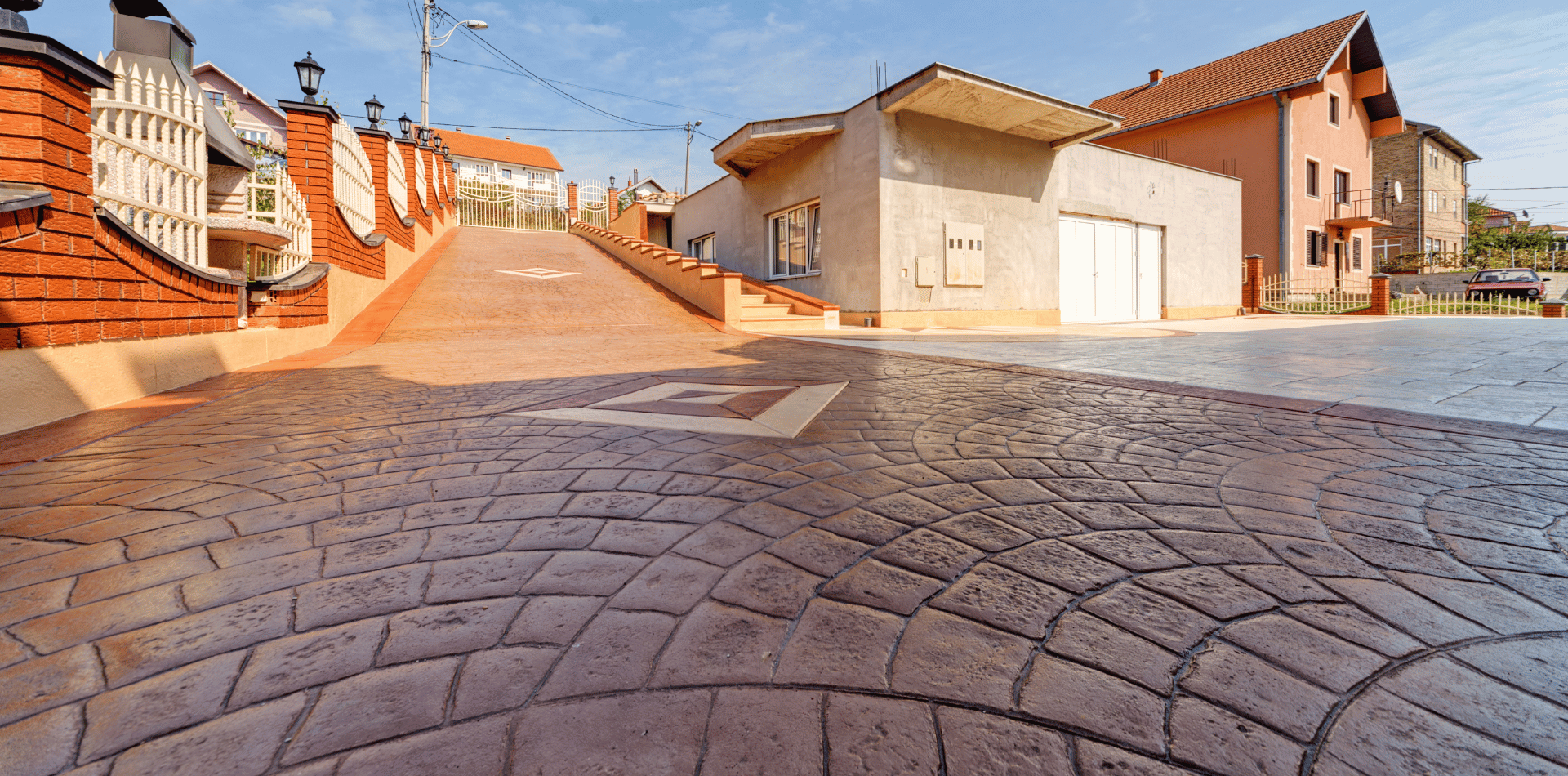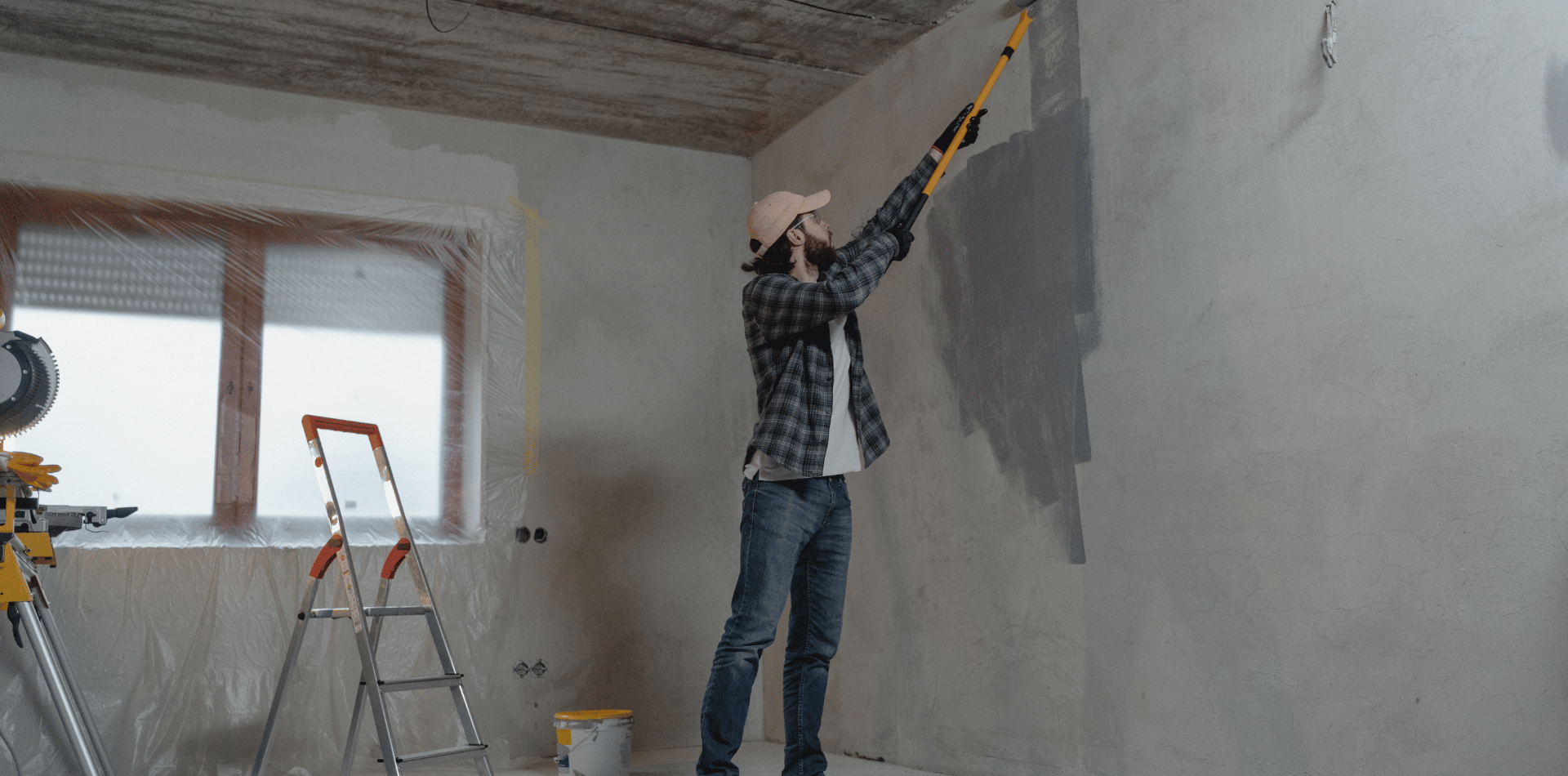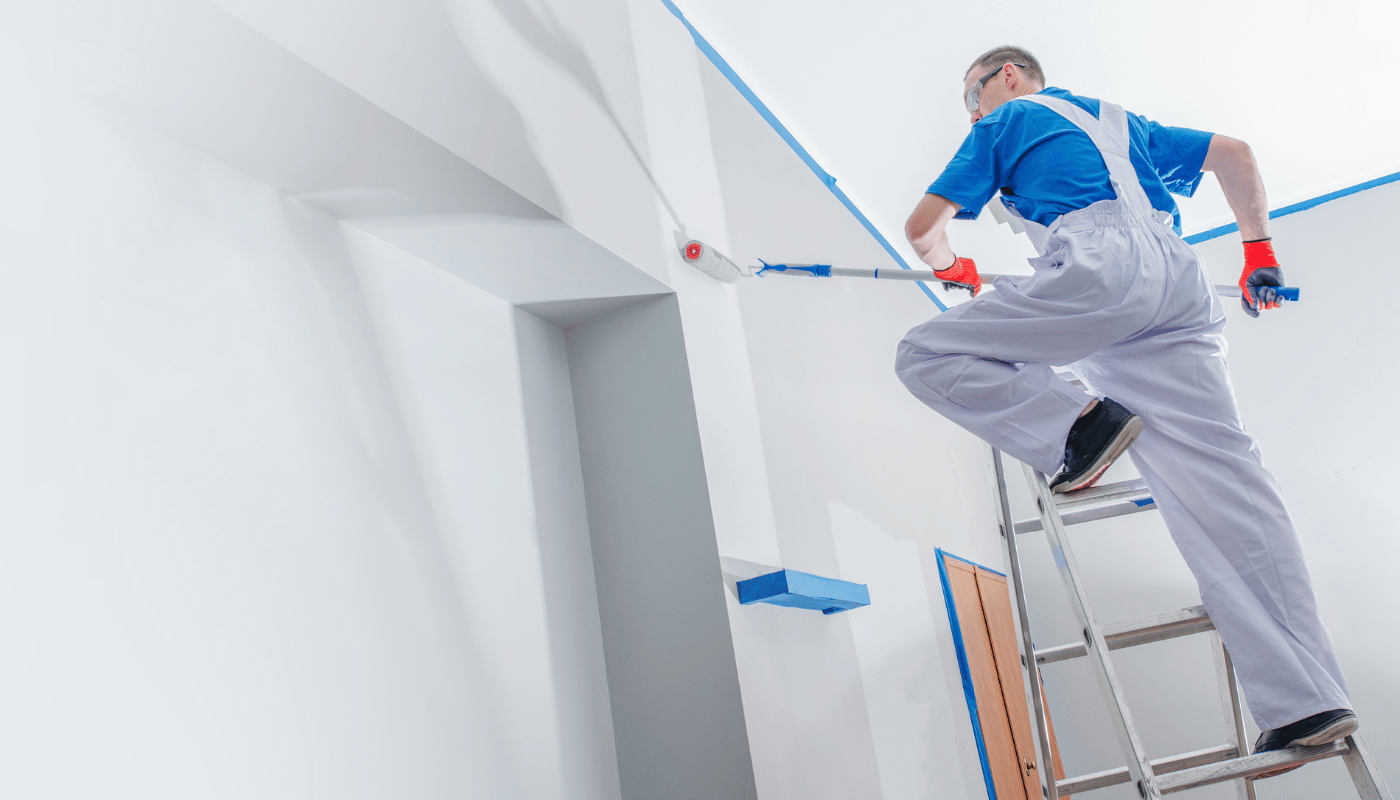Understanding Concrete Paint: What Sets It Apart from House Paint?

When it comes to giving a fresh look to your home or any structure, paint plays a crucial role.
However, not all paints are created equal.
One of the critical distinctions lies between concrete paint and house paint. Understanding these differences is essential for ensuring the longevity and appearance of the surfaces you paint.
Here, we delve into the specifics of concrete paint, highlighting why it stands apart from traditional house paint.
What is Concrete Paint?
Concrete paint is a specialised coating formulated to adhere to the rough, porous surface of concrete. Unlike typical house paint, which is designed for smoother surfaces like wood, drywall, or plaster, concrete paint needs to penetrate and bond effectively with concrete to ensure durability and protection.
Key Characteristics of Concrete Paint
Adhesion and Penetration: The Cornerstones of Concrete Paint Performance
Concrete, a ubiquitous material in both residential and commercial constructions, presents unique challenges when it comes to painting. Its porous nature, while contributing to its strength and versatility, necessitates a specialised approach for effective coating. This is where concrete paint shines, particularly through its superior adhesion and penetration properties.
Understanding Concrete's Porosity
Concrete is inherently porous, which means it contains numerous tiny holes and capillaries that can absorb moisture, chemicals, and other substances. This porosity varies depending on the concrete mix, curing process, and environmental conditions, but it generally results in a surface that is not smooth or impermeable.
Porosity and Its Challenges:
- Moisture Absorption: Concrete readily absorbs water, which can lead to issues such as efflorescence (a white, powdery deposit on the surface), mold growth, and structural damage if moisture gets trapped within the concrete.
- Chemical Sensitivity: Chemicals, such as salts and oils, can penetrate concrete and cause degradation over time, compromising the integrity of the structure.
- Surface Roughness: The rough and uneven surface of concrete makes it difficult for standard paints to adhere properly, leading to peeling, flaking, and a generally unsatisfactory finish.
How Concrete Paint Addresses These Challenges
Concrete paint is specifically formulated to tackle the unique issues posed by concrete surfaces.
Let's explore how its adhesion and penetration properties set it apart:
Enhanced Adhesion:
- Bonding Agents: Concrete paint includes bonding agents that help the paint adhere to the rough and porous surface of concrete. These agents ensure a strong bond between the paint and the substrate, reducing the likelihood of peeling or flaking over time.
- Mechanical Bonding: The rough texture of concrete allows the paint to grip the surface physically. This mechanical bonding, combined with the chemical bonding from the bonding agents, creates a durable and long-lasting coating.
Deep Penetration:
- Pore Filling: Concrete paint is designed to penetrate deeply into the pores and capillaries of the concrete. This penetration not only helps with adhesion but also fills the pores, creating a more uniform and sealed surface.
- Moisture Barrier: By penetrating and filling the pores, concrete paint acts as a barrier to moisture ingress. This is crucial for preventing problems like efflorescence, mould growth, and freeze-thaw damage, where trapped moisture can freeze, expand, and cause the concrete to crack.
Specialised Formulations:
- Acrylic and Epoxy Bases: Many concrete paints are based on acrylic or epoxy formulations. Acrylic paints are known for their flexibility and UV resistance, making them suitable for outdoor applications. Epoxy paints, on the other hand, offer superior chemical resistance and are often used in industrial settings.
- Additives for Performance: Concrete paints often include additives that enhance their performance characteristics. For example, anti-slip additives can be incorporated for floor surfaces, and UV stabilisers can be added to prevent fading from sun exposure.
Preparation and Priming:
- Surface Preparation: Proper surface preparation is critical for concrete paint adhesion. This often involves cleaning the surface to remove dirt, oil, and existing coatings, as well as etching the concrete to open up the pores and create a rougher surface for the paint to adhere to.
- Primers: Using a primer designed for concrete can further enhance adhesion and penetration. Primers often contain additional bonding agents and are formulated to penetrate deeply into the concrete, creating an ideal base for the topcoat of concrete paint.
The Practical Benefits of Superior Adhesion and Penetration
Long-Term Durability:
- Concrete paint that adheres well and penetrates deeply will last longer, reducing the need for frequent repainting and maintenance. This is particularly important for outdoor surfaces exposed to the elements and high-traffic areas such as driveways, walkways, and garages.
Enhanced Aesthetics:
- A paint that bonds effectively to concrete will maintain its appearance better over time. It is less likely to suffer from common paint failures like peeling, cracking, or bubbling, ensuring a consistently attractive finish.
Protection and Preservation:
- By sealing the pores and providing a moisture barrier, concrete paint protects the underlying concrete from environmental damage. This preservation extends the life of the concrete structure and maintains its structural integrity.
The adhesion and penetration properties of concrete paint are fundamental to its effectiveness and set it apart from traditional house paint. By understanding and leveraging these properties, you can ensure that your concrete surfaces are not only aesthetically pleasing but also protected and durable. Whether you are working on a residential patio or a commercial warehouse floor, choosing the right concrete paint and applying it correctly will make all the difference in the longevity and performance of your project.

Durability: The Pillar of Concrete Paint's Superiority
Durability is a critical factor when choosing paint for concrete surfaces, given the demanding conditions these surfaces often face. Concrete paint is engineered to endure harsh environments, providing long-lasting protection and maintaining its appearance under stress.
Let's delve deeper into how concrete paint achieves its exceptional durability and why it is the go-to choice for challenging applications.
Key Durability Features of Concrete Paint
Water Resistance:
- Moisture Barrier: Concrete paint forms a protective barrier that prevents water from penetrating the surface. This is crucial for preventing water damage, which can lead to issues such as efflorescence, mould growth, and freeze-thaw cycles that cause cracking and spalling.
- Hydrophobic Properties: Many concrete paints include hydrophobic (water-repelling) additives that enhance their water resistance. This ensures that water beads up and rolls off the surface rather than being absorbed.
Chemical Resistance:
- Protective Coating: Concrete paint is formulated to resist a wide range of chemicals, including oils, solvents, and acids. This makes it ideal for use in garages, industrial settings, and other environments where chemical spills are common.
- Corrosion Prevention: By providing a chemical-resistant barrier, concrete paint helps protect the concrete from corrosive substances that can degrade its structural integrity over time.
Abrasion Resistance:
- Durable Finish: Concrete surfaces often experience heavy foot traffic, vehicle traffic, and the movement of heavy equipment. Concrete paint is designed to withstand such abrasion, ensuring the surface remains intact and the paint finish stays looking good.
- Hard-Wearing Formulations: Epoxy-based concrete paints, in particular, are known for their exceptional hardness and abrasion resistance, making them a preferred choice for high-traffic areas like warehouses and factories.
UV Resistance:
- Sun Protection: Outdoor concrete surfaces are exposed to sunlight, which can cause fading, chalking, and deterioration of ordinary paints. Concrete paint includes UV-resistant components that protect it from the harmful effects of UV rays, maintaining its color and integrity over time.
- Longevity: By resisting UV damage, concrete paint ensures that outdoor surfaces retain their aesthetic appeal and do not require frequent repainting.
Applications Benefiting from Durable Concrete Paint
Outdoor Surfaces:
- Driveways and Walkways: Concrete paint's durability makes it ideal for driveways and walkways, which endure constant exposure to weather and traffic. Its resistance to water, chemicals, and UV rays ensures these surfaces remain protected and attractive.
- Patios and Pool Decks: These areas benefit from concrete paint's ability to resist moisture and UV damage, providing a slip-resistant, long-lasting finish that enhances safety and appearance.
Garages and Basements:
- Garage Floors: In garages, concrete paint must withstand the weight of vehicles, exposure to oils and chemicals, and frequent cleaning. Its abrasion and chemical resistance make it perfect for this environment.
- Basement Floors: Basements often suffer from moisture issues. Concrete paint provides a moisture-resistant barrier that protects the floor from dampness and potential mold growth.
Industrial and Commercial Settings:
- Warehouses: The heavy machinery and constant movement of goods in warehouses demand a paint that can endure significant wear and tear. Concrete paint's durability ensures the floor remains intact and easy to clean.
- Factories: Factories with exposure to chemicals, heavy traffic, and potential spills require a tough, resilient coating. Concrete paint's chemical resistance and abrasion resistance make it a practical solution.
Technical Aspects Enhancing Durability
Formulation Ingredients:
- Epoxy Resins: Epoxy-based concrete paints are renowned for their strength and durability. They create a hard, glossy finish that resists abrasions, chemicals, and impacts.
- Acrylic Polymers: Acrylic-based concrete paints offer flexibility and UV resistance, making them suitable for outdoor applications where temperature variations can cause expansion and contraction of the surface.
Additives for Enhanced Performance:
- Anti-Slip Additives: For areas where slip resistance is critical, such as pool decks and commercial kitchens, anti-slip additives can be incorporated into concrete paint to provide a textured, safe surface.
- Flexibility Enhancers: Certain additives improve the flexibility of the paint, allowing it to accommodate minor movements and prevent cracking.
Multi-Coat Systems:
- Primer Coats: Applying a primer before the topcoat enhances adhesion and penetration, providing a solid base for the concrete paint.
- Top Coats: Multiple layers of topcoat can be applied to achieve the desired thickness and durability, offering maximum protection and a high-quality finish.
Concrete paint's durability is a cornerstone of its effectiveness and versatility. Its ability to resist water, chemicals, abrasion, and UV rays makes it the ideal choice for a wide range of applications, from residential patios to industrial warehouses. By understanding and leveraging these durability features, you can ensure that your concrete surfaces not only look great but also remain protected and functional for years to come. Whether you are tackling a DIY home improvement project or managing a large commercial facility, selecting the right concrete paint will provide the performance and longevity your surfaces need.
Breathability: A Crucial Attribute of Concrete Paint
Concrete is a durable and versatile building material, but it has unique characteristics that require special consideration when choosing a paint. One of the most important features of concrete paint is its breathability. This property allows moisture within the concrete to escape, preventing a host of problems such as mould, mildew, and structural damage.
In this section, we will explore why breathability is essential for concrete paint and how it contributes to the longevity and health of concrete structures.
Understanding Concrete's Need to Breathe
Concrete, by its nature, is a porous material. It absorbs water during the curing process and can continue to absorb moisture from the environment throughout its lifespan. This retained moisture needs a way to escape to prevent damage.
Key Issues Related to Moisture:
- Efflorescence: When water within concrete evaporates, it can leave behind salt deposits on the surface, resulting in a white, powdery residue known as efflorescence.
- Mould and Mildew: Trapped moisture can create a breeding ground for mould and mildew, particularly in basements, bathrooms, and other humid areas.
- Freeze-Thaw Damage: In cold climates, water trapped within concrete can freeze, expand, and cause the concrete to crack and spall.
- Structural Damage: Prolonged moisture buildup can weaken the concrete, leading to structural integrity issues over time.
How Breathable Concrete Paint Works
Breathable concrete paint is designed to allow moisture vapour to pass through the paint film while preventing liquid water from penetrating the surface. This dual function is achieved through advanced formulations that balance permeability and protection.
Permeability:
- Micro-Porous Structure: Breathable concrete paints have a micro-porous structure that allows water vapor to escape from the concrete while keeping liquid water out. This helps maintain a dry interior within the concrete structure.
- Water Vapor Transmission Rate (WVTR): The WVTR is a measure of how effectively moisture can pass through the paint. Breathable paints have a high WVTR, ensuring efficient moisture release.
Protection Against Liquid Water:
- Hydrophobic Properties: While allowing vapour to pass, breathable paints often include hydrophobic (water-repelling) components that prevent liquid water from seeping into the concrete. This dual action protects the concrete from external moisture sources such as rain and humidity.
Benefits of Breathable Concrete Paint
Prevention of Mold and Mildew:
- Health and Safety: By allowing moisture to escape, breathable concrete paint reduces the risk of mold and mildew growth, which can pose health risks and create unpleasant odors.
- Aesthetic Maintenance: Mold and mildew can stain concrete surfaces, detracting from their appearance. Breathable paint helps maintain a clean, fresh look.
Minimisation of Efflorescence:
- Surface Appearance: Efflorescence can mar the appearance of concrete surfaces with unsightly white deposits. Breathable paint helps prevent this by allowing moisture to evaporate without leaving behind salts.
- Ease of Maintenance: Surfaces treated with breathable paint require less frequent cleaning and maintenance to remove efflorescence.
Protection from Freeze-Thaw Cycles:
- Structural Integrity: In cold climates, breathable paint helps prevent freeze-thaw damage by allowing moisture to escape before it can freeze and expand. This reduces the risk of cracking and spalling.
- Longevity: By mitigating freeze-thaw damage, breathable paint extends the lifespan of concrete structures, reducing the need for repairs and replacements.
Overall Structural Health:
- Dry Concrete: Keeping concrete dry is essential for maintaining its strength and durability. Breathable paint ensures that moisture does not accumulate within the concrete, preserving its structural integrity.
- Reduced Maintenance Costs: With fewer issues related to moisture, structures painted with breathable concrete paint require less maintenance and fewer repairs, leading to cost savings over time.
Applications Where Breathability is Crucial
Historic Buildings:
- Preservation: Many historic buildings are constructed from concrete or masonry materials that need to breathe. Breathable paint is essential for preserving these structures without trapping moisture that could lead to decay.
- Aesthetic Integrity: Maintaining the original appearance of historic buildings is important. Breathable paints help achieve this by preventing mould, mildew, and efflorescence.
Basements and Cellars:
- Humidity Control: Basements are prone to high humidity levels. Breathable paint allows moisture to escape, reducing the risk of mould and creating a healthier indoor environment.
- Durability: By preventing moisture buildup, breathable paint helps maintain the structural integrity of basement walls and floors.
Bathrooms and Kitchens:
- Moisture Management: These areas experience high levels of moisture from showers, baths, and cooking. Breathable paint helps manage this moisture, preventing damage to walls and ceilings.
- Hygiene: Reducing mould and mildew growth contributes to a cleaner, more hygienic environment.
Exterior Walls:
- Weather Protection: Exterior walls are exposed to rain and humidity. Breathable paint provides protection while allowing trapped moisture to escape, preventing damage from within.
- Climate Adaptability: Breathable paint is suitable for a wide range of climates, ensuring that buildings remain protected and dry regardless of weather conditions.
Breathability is a defining feature of concrete paint that significantly enhances its performance and suitability for a variety of applications. By allowing moisture to escape from within the concrete while preventing external water penetration, breathable paint ensures the longevity, health, and appearance of concrete structures. Whether you are preserving a historic building, finishing a basement, or protecting exterior walls, choosing breathable concrete paint is a wise investment in durability and functionality.
Flexibility: Adapting to the Movement of Concrete Surfaces
Concrete surfaces, though robust and durable, are subject to constant movement. This movement is primarily due to temperature fluctuations, which cause the concrete to expand and contract, as well as other environmental factors like moisture variations and mechanical stress. The flexibility of concrete paint is crucial in accommodating these movements, preventing cracks, and ensuring a long-lasting, smooth finish. In this section, we will explore why flexibility is essential for concrete paint and how it is achieved.
The Dynamics of Concrete Movement
Concrete, despite its strength, is not a static material. It undergoes various forms of movement that can challenge the integrity of any coating applied to it.
Types of Movement:
- Thermal Expansion and Contraction: Changes in temperature cause concrete to expand when heated and contract when cooled. This can lead to significant stress on the surface.
- Moisture-Induced Expansion: Concrete can absorb water, leading to swelling. Conversely, as it dries, it contracts.
- Mechanical Stress: External forces such as traffic, heavy loads, and vibrations can cause concrete to shift and flex.
- Shrinkage: As concrete cures, it can shrink, causing internal stress and potential cracking.
How Flexible Concrete Paint Works
To cope with the dynamic nature of concrete, flexible concrete paint is formulated with special polymers and additives that allow it to move in sync with the substrate.
Here’s how it works:
Flexible Polymers:
- Acrylic and Latex Polymers: These polymers are commonly used in concrete paints for their flexibility. They create a paint film that can stretch and contract without breaking or cracking.
- Elastomeric Resins: These are advanced materials that offer superior flexibility. Elastomeric paints can elongate significantly, making them ideal for surfaces subject to extreme movements.
Crack Bridging:
- Micro-Cracking Resistance: Flexible concrete paints are designed to bridge small cracks in the substrate. This means that as tiny cracks develop in the concrete, the paint stretches to cover them, preventing water ingress and further damage.
- Preventing Crack Propagation: By bridging these micro-cracks, flexible paint helps prevent them from growing into larger, more problematic cracks.
Adhesion Enhancers:
- Bond Strength: Flexible concrete paints often include adhesion promoters that enhance the bond between the paint and the concrete. This ensures that the paint remains firmly attached even as the substrate moves.
- Substrate Compatibility: These paints are formulated to adhere well to a variety of concrete finishes, including smooth and rough surfaces, ensuring consistent performance.
Durability in Harsh Conditions:
- Weather Resistance: Flexible concrete paints are designed to withstand a wide range of environmental conditions, including extreme temperatures, humidity, and UV exposure.
- Long-Term Performance: The flexibility of these paints ensures they remain effective over time, reducing the need for frequent maintenance or recoating.
Benefits of Flexible Concrete Paint
Prevention of Cracks:
- Maintaining Surface Integrity: By moving with the substrate, flexible paint prevents the formation of cracks, maintaining a smooth, uninterrupted surface.
- Waterproofing: Cracks can allow water to penetrate the concrete, leading to further damage. Flexible paint helps keep the surface waterproof by preventing crack formation.
Enhanced Aesthetics:
- Smooth Finish: A flexible paint maintains a smooth, even finish despite the underlying movement of the concrete. This ensures a consistently attractive appearance.
- Longevity of Colour: Flexible paints are less likely to develop unsightly cracks that can detract from the appearance of coloured or decorative concrete surfaces.
Increased Durability:
- Resistance to Environmental Stress: Flexible paint withstands the stresses of expansion, contraction, and mechanical impacts, ensuring long-lasting protection.
- Extended Lifespan: By preventing cracks and maintaining adhesion, flexible paint extends the lifespan of both the coating and the concrete surface.
Versatility in Applications:
- Interior and Exterior Use: Flexible concrete paint is suitable for both indoor and outdoor applications, making it a versatile choice for a wide range of projects.
- Variety of Surfaces: It can be used on various concrete surfaces, including walls, floors, and decorative elements, providing consistent performance across different settings.
Applications Benefiting from Flexible Concrete Paint
Exterior Walls and Facades:
- Thermal Stress: Exterior walls are exposed to significant temperature variations throughout the day and year. Flexible paint accommodates these changes, preventing cracks and maintaining a uniform appearance.
Driveways and Sidewalks:
- Heavy Traffic: These surfaces endure constant mechanical stress from vehicles and foot traffic. Flexible paint helps absorb these stresses, preventing surface damage.
Parking Structures:
- Load Bearing: Parking structures experience dynamic loads from vehicles. Flexible paint ensures the surface can handle these loads without cracking or delaminating.
Basements and Foundations:
- Moisture Management: Subterranean structures like basements and foundations are prone to moisture-induced expansion and contraction. Flexible paint helps manage these movements while maintaining a waterproof barrier.
Decorative Concrete:
- Aesthetic Preservation: Decorative concrete surfaces, such as stamped or stained concrete, benefit from flexible paint that preserves their intricate designs and colors without cracking.
The flexibility of concrete paint is a critical attribute that significantly enhances its performance and durability. By incorporating flexible polymers and advanced formulations, these paints can accommodate the dynamic nature of concrete, preventing cracks and maintaining a smooth, attractive finish. Whether used on exterior walls, driveways, parking structures, or decorative surfaces, flexible concrete paint ensures long-lasting protection and aesthetic appeal, making it an essential choice for any concrete coating project.
Protection: The Essential Role of Concrete Paint in Safeguarding Surfaces
Concrete paint plays a vital role in protecting concrete surfaces from a variety of environmental and man-made hazards. By forming a robust barrier, it guards against water ingress, mitigates freeze-thaw damage, and resists chemical spills. This comprehensive protection is especially crucial in industrial and commercial environments where surfaces are subjected to intense wear and exposure. Here's how concrete paint provides this essential protection.
Water Ingress Prevention
One of the most significant threats to concrete surfaces is water. Unprotected concrete can absorb water, leading to a host of problems.
Moisture Penetration:
- Barrier Formation: Concrete paint creates a waterproof barrier that prevents water from penetrating the surface. This is crucial for preventing water-related damage such as efflorescence, mold growth, and internal deterioration.
- Hydrophobic Additives: Many concrete paints include hydrophobic compounds that repel water, ensuring that the surface remains dry even in wet conditions.
Efflorescence Prevention:
- Salt Migration: Efflorescence occurs when water within the concrete evaporates, leaving behind salt deposits. Concrete paint prevents water ingress, thereby reducing the likelihood of efflorescence and maintaining a clean, attractive appearance.
Structural Integrity:
- Corrosion Protection: Water can carry chemicals that corrode the reinforcing steel within concrete. By keeping water out, concrete paint helps protect the steel reinforcement, maintaining the structural integrity of the concrete.
Mitigating Freeze-Thaw Damage
In regions with cold climates, concrete surfaces are particularly vulnerable to freeze-thaw cycles.
Freeze-Thaw Cycles:
- Expansion and Contraction: When water absorbed by concrete freezes, it expands, causing internal stress that can lead to cracking and spalling. Concrete paint prevents water from entering the concrete, mitigating the damage caused by freeze-thaw cycles.
- Durable Formulation: Concrete paints are formulated to remain flexible and intact even under freezing temperatures, ensuring continuous protection.
Longevity:
- Extended Lifespan: By protecting against freeze-thaw damage, concrete paint extends the lifespan of outdoor concrete surfaces, reducing the need for frequent repairs or replacements.
Chemical Spill Protection
Industrial and commercial environments often expose concrete surfaces to various chemicals, necessitating robust protective measures.
Chemical Resistance:
- Protective Barrier: Concrete paint forms a barrier that resists penetration by oils, solvents, acids, and other chemicals commonly encountered in industrial settings. This protects the concrete from chemical degradation and staining.
- Specialized Formulations: Epoxy and polyurethane-based concrete paints offer superior chemical resistance, making them ideal for use in environments where chemical spills are frequent.
Ease of Cleaning:
- Non-Porous Surface: By sealing the concrete, paint creates a smooth, non-porous surface that is easier to clean and decontaminate. This is particularly important in industries where hygiene and cleanliness are paramount.
Health and Safety:
- Preventing Contamination: In food processing plants, laboratories, and similar settings, preventing chemical contamination of the concrete substrate is critical. Concrete paint ensures that spills are contained on the surface and can be cleaned effectively.
Additional Protective Benefits
UV Protection:
- Sunlight Exposure: UV rays from the sun can cause concrete to degrade over time, leading to discolouration and weakening. Concrete paint with UV-resistant properties protects the surface from these harmful effects, maintaining both the appearance and strength of the concrete.
- Colour Retention: UV-resistant concrete paint helps maintain the colour and finish of the surface, preventing fading and chalking.
Abrasion Resistance:
- Surface Wear: High-traffic areas, whether pedestrian or vehicular, require durable surfaces that can withstand continuous use. Concrete paint with abrasion-resistant properties protects the surface from wear and tear, ensuring it remains intact and attractive.
- Impact Resistance: In industrial environments, concrete surfaces are often subjected to impacts from machinery, tools, and other heavy objects. Abrasion-resistant concrete paint helps absorb and distribute these impacts, preventing surface damage.
Stain Resistance:
- Maintaining Appearance: Stains from oil, grease, and other substances can mar the appearance of concrete. Concrete paint with stain-resistant properties makes it easier to clean spills and maintain a pristine surface.
- Long-Term Cleanliness: Stain resistance ensures that concrete surfaces remain clean and presentable, reducing the effort and cost associated with maintenance.
Practical Applications of Protective Concrete Paint
Industrial Floors:
- Heavy Machinery: In factories and warehouses, concrete floors are subjected to heavy machinery and constant traffic. Protective concrete paint ensures these surfaces remain durable and safe.
- Chemical Exposure: Industries that handle chemicals benefit from the chemical resistance of concrete paint, protecting floors from spills and splashes.
Commercial Spaces:
- Retail Environments: In retail spaces, concrete floors must be both durable and visually appealing. Protective concrete paint provides a high-quality finish that can withstand foot traffic and maintain its appearance.
- Service Areas: Areas like kitchens and bathrooms in commercial buildings require protection from moisture and stains. Concrete paint offers a reliable solution.
Parking Structures:
- Vehicle Traffic: Parking garages and lots endure constant vehicular traffic, oil drips, and exposure to the elements. Concrete paint with high durability ensures these surfaces remain protected and easy to clean.
- Weather Protection: The protective properties of concrete paint guard against water ingress and freeze-thaw cycles, extending the life of parking structures.
Public Infrastructure:
- Bridges and Tunnels: Public infrastructure projects often involve concrete surfaces exposed to harsh conditions. Protective concrete paint helps preserve these structures, ensuring their safety and longevity.
- Sidewalks and Pathways: Sidewalks and pedestrian pathways benefit from the abrasion resistance and weather protection provided by concrete paint, ensuring safe and durable walking surfaces.
Concrete paint's protective qualities are essential for maintaining the integrity and appearance of concrete surfaces in a variety of settings. By preventing water ingress, reducing freeze-thaw damage, and resisting chemical spills, concrete paint ensures that surfaces remain durable and functional. Whether in industrial floors, commercial spaces, parking structures, or public infrastructure, the protection offered by concrete paint is invaluable. Investing in high-quality, protective concrete paint is a smart choice that leads to long-term savings and superior performance of concrete surfaces.





